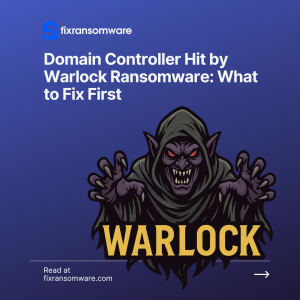When Warlock hits your Domain Controller (DC), identity, logons, and trust relationships can collapse in minutes. The mission is clear: contain, preserve evidence, restore Active Directory (AD) cleanly, then re-harden so it doesn’t happen again. If you need hands-on triage and a clean-restore plan, start an assessment at FixRansomware.com.
Warlock on a Domain Controller: Priorities in Plain English
- Stop spread and prevent more encryption.
- Capture artifacts for forensics and insurance.
- Restore AD safely (no data corruption), confirm replication health, then reopen services in stages.
Baseline guidance: CISA Stop Ransomware.
Contain Warlock Without Destroying Evidence (First 30 Minutes)
- Isolate the DC: remove from the network or disable switch ports; avoid hard power-offs unless safety requires it.
- Preserve state: don’t wipe or run random “decryptors.” Snapshot disks if your policy allows, and export key logs.
- Tighten access: suspend nonessential admin accounts; lock down remote management; review recent privileged logons.
- Collect evidence: ransom notes, timestamps, affected roles, recent GPO edits, unusual services/tasks, EDR alerts.
Clean AD Restore: Minimal Chaos, Maximum Integrity
- Landing zone & hygiene.
Work from a clean admin workstation and known-good credentials. If multiple DCs exist, identify a gold source (the least affected DC or a pre-incident backup). - Backups before fixes.
Validate pre-incident system state backups (immutable/offline). If restoring a DC, plan non-authoritative vs authoritative elements carefully. - SYSVOL and replication.
After a restore, check DFS-R/SYSVOL status,dcdiag, andrepadmin /replsummary. If SYSVOL is inconsistent, consider an authoritative SYSVOL procedure. - KRBTGT reset (twice).
Assume Kerberos tickets and hashes could be abused. Reset the KRBTGT account password twice, with replication settling between resets, to invalidate old tickets. - RID pool & metadata cleanup.
If a DC is unrecoverable, perform metadata cleanup and verify RID pool health before bringing new DCs online. - Stage critical services.
Bring Identity/Directory fully healthy first, then DNS, then core line-of-business services. Keep sensitive apps fenced until hardening completes.
Forensics That Matter in a Warlock Case
- Likely vectors: exposed RDP, weak VPN/MFA, credential reuse/leaks, unmanaged admin workstations, or vulnerable management portals.
- Pull Security, Directory Service, DNS Server, and DFS-R logs; export Event Forwarding, EDR telemetry, GPO change history, and privileged group changes.
- Create read-only images of impacted systems for legal/regulatory needs and insurance claims.
Post-Incident Hardening (Close the Doors Warlock Used)
- Identity & Access
- Enforce MFA for all admin paths (AD, VPN, hypervisors, backup consoles).
- Rotate all service/local admin passwords; implement LAPS and stop shared admin use.
- Review Tiered Admin model; separate admin workstations from user networks.
- Patch & Exposure Reduction
- Patch DCs, member servers, VPN/edge devices. Close unused ports/services; remove risky legacy protocols.
- Segregate management, server, and user VLANs; restrict east-west traffic.
- Backups That Survive Ransomware
- Apply 3-2-1 with one immutable/offline copy. Test authoritative/non-authoritative restores quarterly (table-top + live drills).
- Monitoring & Detection
- SIEM alerts for mass rename/encryption patterns, suspicious admin logons, GPO changes, and DC sync/replication anomalies.
- EDR on admin endpoints; restrict PowerShell remoting and sign scripts.
Should You Pay?
Paying is risky and often unnecessary; it doesn’t guarantee decryption and increases double extortion exposure. A verifiable, clean AD restore plus identity hardening is the durable fix. For scoped assistance aligned to best practices, contact FixRansomware.com.


